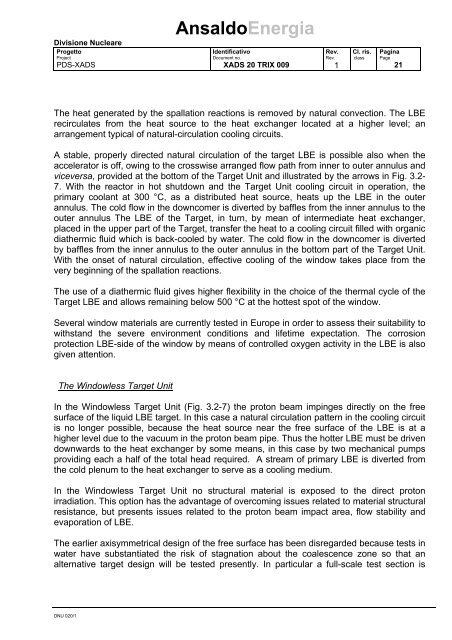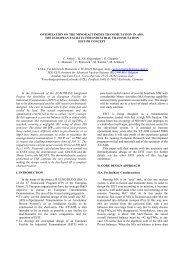AnsaldoEnergia
AnsaldoEnergia - KIT
AnsaldoEnergia - KIT
- No tags were found...
Create successful ePaper yourself
Turn your PDF publications into a flip-book with our unique Google optimized e-Paper software.
Divisione Nucleare<br />
Progetto<br />
Project<br />
PDS-XADS<br />
<strong>AnsaldoEnergia</strong><br />
Identificativo<br />
Document no.<br />
XADS 20 TRIX 009<br />
Rev.<br />
Rev.<br />
1<br />
Cl. ris.<br />
class<br />
Pagina<br />
Page<br />
21<br />
The heat generated by the spallation reactions is removed by natural convection. The LBE<br />
recirculates from the heat source to the heat exchanger located at a higher level; an<br />
arrangement typical of natural-circulation cooling circuits.<br />
A stable, properly directed natural circulation of the target LBE is possible also when the<br />
accelerator is off, owing to the crosswise arranged flow path from inner to outer annulus and<br />
viceversa, provided at the bottom of the Target Unit and illustrated by the arrows in Fig. 3.2-<br />
7. With the reactor in hot shutdown and the Target Unit cooling circuit in operation, the<br />
primary coolant at 300 °C, as a distributed heat source, heats up the LBE in the outer<br />
annulus. The cold flow in the downcomer is diverted by baffles from the inner annulus to the<br />
outer annulus The LBE of the Target, in turn, by mean of intermediate heat exchanger,<br />
placed in the upper part of the Target, transfer the heat to a cooling circuit filled with organic<br />
diathermic fluid which is back-cooled by water. The cold flow in the downcomer is diverted<br />
by baffles from the inner annulus to the outer annulus in the bottom part of the Target Unit.<br />
With the onset of natural circulation, effective cooling of the window takes place from the<br />
very beginning of the spallation reactions.<br />
The use of a diathermic fluid gives higher flexibility in the choice of the thermal cycle of the<br />
Target LBE and allows remaining below 500 °C at the hottest spot of the window.<br />
Several window materials are currently tested in Europe in order to assess their suitability to<br />
withstand the severe environment conditions and lifetime expectation. The corrosion<br />
protection LBE-side of the window by means of controlled oxygen activity in the LBE is also<br />
given attention.<br />
The Windowless Target Unit<br />
In the Windowless Target Unit (Fig. 3.2-7) the proton beam impinges directly on the free<br />
surface of the liquid LBE target. In this case a natural circulation pattern in the cooling circuit<br />
is no longer possible, because the heat source near the free surface of the LBE is at a<br />
higher level due to the vacuum in the proton beam pipe. Thus the hotter LBE must be driven<br />
downwards to the heat exchanger by some means, in this case by two mechanical pumps<br />
providing each a half of the total head required. A stream of primary LBE is diverted from<br />
the cold plenum to the heat exchanger to serve as a cooling medium.<br />
In the Windowless Target Unit no structural material is exposed to the direct proton<br />
irradiation. This option has the advantage of overcoming issues related to material structural<br />
resistance, but presents issues related to the proton beam impact area, flow stability and<br />
evaporation of LBE.<br />
The earlier axisymmetrical design of the free surface has been disregarded because tests in<br />
water have substantiated the risk of stagnation about the coalescence zone so that an<br />
alternative target design will be tested presently. In particular a full-scale test section is<br />
DNU 020/1





